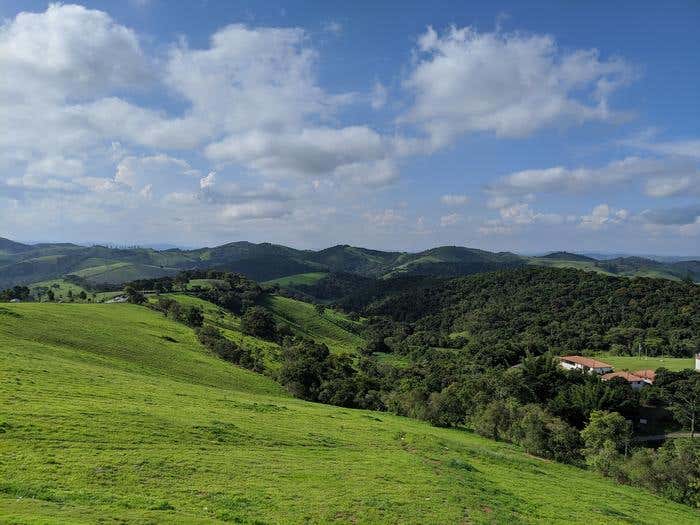The complex science of planting trees to combat climate change
Using trees as a cost-effective tool against climate change is more complicated than simply planting large numbers of them

A mixed use landscape in Brazil with potential for restoration. (CREDIT: Jacob Bukoski)
Using trees as a tool to combat climate change involves more complexity than just planting large numbers of them. An international study, which includes an Oregon State University scientist, highlights this point.
Jacob Bukoski from the OSU College of Forestry, along with seven other researchers, analyzed data from thousands of reforestation sites in 130 countries. They discovered that in about half of the cases, it’s better to allow nature to take its course rather than actively planting trees.
The study, led by Conservation International, was published in Nature Climate Change. Bukoski explains, "Trees can play a role in climate change mitigation for multiple reasons. It's easy to understand that forests pull carbon dioxide from the atmosphere and store it. Trees are something almost everyone supports – we've seen bipartisan acts for tree planting introduced in Congress. This study provides a nuanced view on whether planting trees should be our primary solution to climate change."
Expanding forests globally has been a widely proposed tactic against climate change since forests sequester carbon dioxide in their biomass and soils. Additionally, harvested timber stores carbon in wood products. However, there are two main approaches to forest expansion: letting forests regenerate naturally or actively planting them.
"Generally speaking, letting forests regenerate on their own is slow but cheap, whereas actively planting them speeds up growth but is more expensive," Bukoski states. "Our study compares these two methods across reforestable landscapes in low- and middle-income countries, identifying where natural regeneration or planting makes more sense."
Using machine learning and regression models, the researchers found that natural regeneration would be most cost-effective over a 30-year period for 46% of the areas studied, while planting would be most cost-effective for 54%. They also determined that using a combination of both approaches across all areas would be 44% better than natural regeneration alone and 39% better than planting alone.
Related Stories
“If your objective is to sequester carbon as quickly and as cheaply as possible, the best option is a mix of both naturally regenerating forests and planting forests,” Bukoski says.
The study suggests that natural regeneration is especially cost-effective relative to plantation forestry in regions like western Mexico, the Andean region, the Southern Cone of South America, West and Central Africa, India, Southern China, Malaysia, and Indonesia. In contrast, plantations are more cost-effective in the Caribbean, Central America, Brazil, northern China, mainland Southeast Asia, the Philippines, and North, East, and Southern Africa.
“Which method is more cost-effective in a given location depends on multiple factors, including opportunity cost, relative carbon accumulation and harvest rates, and relative implementation costs,” Bukoski explains.
Other scientists in the collaboration include Jonah Busch and Bronson Griscom of Conservation International, Susan Cook-Patton of The Nature Conservancy, David Kaczan of the World Bank, Yuanyuan Yi of Peking University, Jeff Vincent of Duke University, and Matthew Potts of the University of California, Berkeley.
The authors emphasize that reforestation should complement, not replace, efforts to reduce emissions from fossil fuels. They note that achieving the full mitigation potential of reforestation over 30 years would amount to less than eight months of global greenhouse gas emissions.
Furthermore, they point out that carbon is just one consideration when growing trees. Biodiversity, demand for wood products, support for local livelihoods, and non-carbon biophysical effects must also be considered when deciding where and how to reforest landscapes.
The findings of this study suggest that reforestation offers far more potential for low-cost climate mitigation than previously estimated. By understanding the cost-effectiveness of different reforestation methods across various regions, better strategies can be developed to optimize the role of forests in combating climate change.
Note: Materials provided above by The Brighter Side of News. Content may be edited for style and length.
Like these kind of feel good stories? Get The Brighter Side of News' newsletter.
Joshua Shavit
Science & Technology Writer | AI and Robotics Reporter
Joshua Shavit is a Los Angeles-based science and technology writer with a passion for exploring the breakthroughs shaping the future. As a contributor to The Brighter Side of News, he focuses on positive and transformative advancements in AI, technology, physics, engineering, robotics and space science. Joshua is currently working towards a Bachelor of Science in Business Administration at the University of California, Berkeley. He combines his academic background with a talent for storytelling, making complex scientific discoveries engaging and accessible. His work highlights the innovators behind the ideas, bringing readers closer to the people driving progress.



